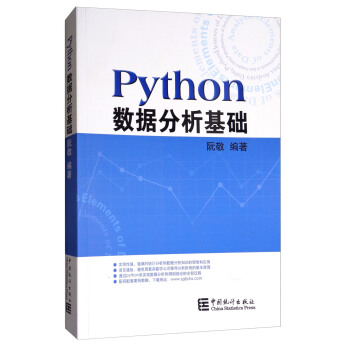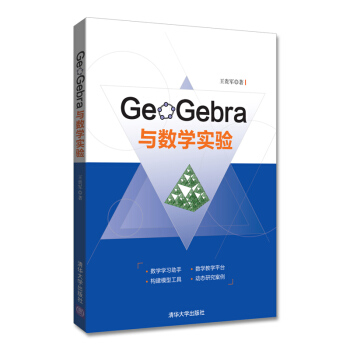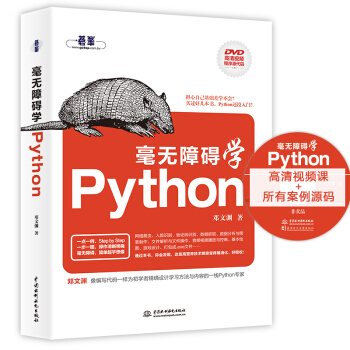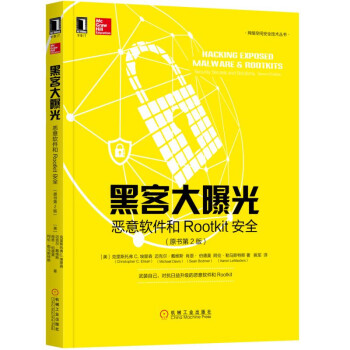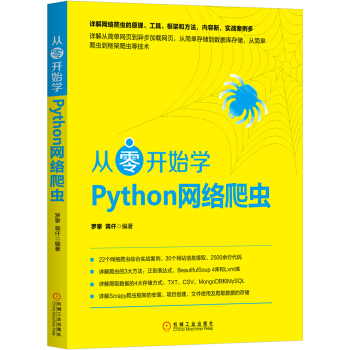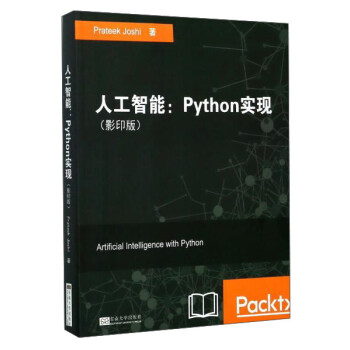

具体描述
內容簡介
在現代世界中,所有一切都是由技術和數據所驅動。而人工智能與這個世界的關係正在變得愈加緊密。人工智能被廣泛應用於多個領域,例如搜索引擎、圖像識彆、機器人學、金融等。我們會在《人工智能:Python實現(影印版 英文版)》中探索各種現實世界的真實場景,學習各種可以用於構建人工智能應用的算法。《人工智能:Python實現(影印版 英文版)》的閱讀過程中,你將學會如何就特定場景下該使用何種算法作齣明智的決定。首先我們會介紹人工智能的基本知識,從中學習利用各種數據挖掘技術開發各種構建塊的方法。你會看到如何實現不同的算法來得到佳的預期結果,理解如何將其應用於現實場景。如果你想為基於圖像、文本、股市或其他形式數據的應用程序添加上智能層,這本激動人心的人工智能書籍絕對能夠作為你的指南!
目錄
PrefaceChapter 1: Introduction to Artificial Intelligence
What is Artificial Intelligence?
Why do we need to study AI?
Applications of AI
Branches of AI
Defining intelligence using Turing Test
Making machines think like humans
Building rational agents
General Problem Solver
Solving a problem with GPS
Building an intelligent agent
Types of models
Installing Python 3
Installing on Ubuntu
Installing on Mac OS X
Installing on Windows
Installing packages
Loading data
Summary
Chapter 2: Classification and Regression Using Supervised Learning
Supervised versus unsupervised learning
What is classification?
Preprocessing data
Binarization
Mean removal
Scaling
Normalization
Label encoding
Logistic Regression classifier
Naive Bayes classifier
Confusion matrix
Support Vector Machines
Classifying income data using Support Vector Machines
What is Regression?
Building a single variable regressor
Building a multivariable regressor
Estimating housing prices using a Support Vector Regressor
Summary
Chapter 3: Predictive Analytics with Ensemble Learning
What is Ensemble Learning?
Building learning models with Ensemble Learning
What are Decision Trees?
Building a Decision Tree classifier
What are Random Forests and Extremely Random Forests?
Building Random Forest and Extremely Random Forest classifiers
Estimating the confidence measure of the predictions
Dealing with class imbalance
Finding optimal training parameters using grid search
Computing relative feature importance
Predicting traffic using Extremely Random Forest regressor
Summary
Chapter 4: Detecting Patterns with Unsupervised Learning
What is unsupervised learning?
Clustering data with K-Means algorithm
Estimating the number of clusters with Mean Shift algorithm
Estimating the quality of clustering with silhouette scores
What are Gaussian Mixture Models?
Building a classifier based on Gaussian Mixture Models
Finding subgroups in stock market using Affinity Propagation model
Segmenting the market based on shopping patterns
Summary
Chapter 5: Building Recommender Systems
Creating a training pipeline
Extracting the nearest neighbors
Building a K-Nearest Neighbors classifier
Computing similarity scores
Finding similar users using collaborative filtering
Building a movie recommendation system
Summary
Chapter 6: Logic Programming
What is logic programming?
Understanding the building blocks of logic programming
Solving problems using logic programming
Installing Python packages
Matching mathematical expressions
Validating primes
Parsing a family tree
Analyzing geography
Building a puzzle solver
Summary
Chapter 7: Heuristic Search Techniques
What is heuristic search?
Uninformed versus Informed search
Constraint Satisfaction Problems
Local search techniques
Simulated Annealing
Constructing a string using greedy search
Solving a problem with constraints
Solving the region-coloring problem
Building an 8-puzzle solver
Building a maze solver
Summary
Chapter 8: Genetic Algorithms
Understanding evolutionary and genetic algorithms
Fundamental concepts in genetic algorithms
Generating a bit pattern with predefined parameters
Visualizing the evolution
Solving the symbol regression problem
Building an intelligent robot controller
Summary
Chapter 9: Building Games With Artificial Intelligence
Using search algorithms in games
Combinatorial search
Minimax algorithm
Alpha-Beta pruning
Negamax algorithm
Installing easyAI library
Ruildina a bot to olav Last Coin Standina
Building a bot to play Tic-Tac-Toe
Building two bots to play Connect FourTM against each other
Building two bots to play Hexapawn against each other
Summary
Chapter 10: Natural Language Processing
Introduction and installation of packages
Tokenizing text data
Converting words to their base forms using stemming
Converting words to their base forms using lemmatization
Dividing text data into chunks
Extracting the frequency of terms using a Bag of Words model
Building a category predictor
Constructing a gender identifier
Building a sentiment analyzer
Topic modeling using Latent Dirichlet Allocation
Summary
Chapter 11: Probabilistic Reasoning for Sequential Data
Understanding sequential data
Handling time-series data with Pandas
Slicing time-series data
Operating on time-series data
Extracting statistics from time-series data
Generating data using Hidden Markov Models
Identifying alphabet sequences with Conditional Random Fields
Stock market analysis
Summary
Chapter 12: Building A Speech Recognizer
Working with speech signals
Visualizing audio signals
Transforming audio signals to the frequency domain
Generating audio signals
Synthesizing tones to generate music
Extracting speech features
Recognizing spoken words
Summary
Chapter 13: Object Detection and Tracking
Installing OpenCV
Frame differencing
Tracking objects using colorspaces
Object tracking using background subtraction
Building an interactive object tracker using the CAMShift algorithm
Optical flow based tracking
Face detection and tracking
Using Haar cascades for object detection
Using integral images for feature extraction
Eye detection and tracking
Summary
Chapter 14: Artificial Neural Networks
Introduction to artificial neural networks
Building a neural network
Training a neural network
Building a Perceptron based classifier
Constructing a single layer neural network
Constructing a multilayer neural network
Building a vector quantizer
Analyzing sequential data using recurrent neural networks
Visualizing characters i,! an Optical Character Recognition database
Building an Optical Character Recognition engine
Summary
Chapter 15: Reinforcement Learning
Understanding the premise
Reinforcement learning versus supervised learning
Real world examples of reinforcement learning
Building blocks of reinforcement learning
Creating an environment
Building a learning agent
Summary
Chapter 16: Deep Learning with Convolutional Neural Networks
What are Convolutional Neural Networks?
Architecture of CNNs
Types of layers in a CNN
Building a perceptron-based linear regressor
Building an image classifier using a single layer neural network
Building an image classifier using a Convolutional Neural Network
Summary
Index
用户评价
這本書的封麵和“影印版”的字樣,立刻勾起瞭我當年學習技術的“懷舊”情懷,也讓我看到瞭它在專業性和原汁原味上的優勢。我一直相信,要深入理解人工智能這樣的復雜領域,英文原版書籍是繞不開的。中文的翻譯在很多時候為瞭易懂,可能會犧牲掉一些精確性,尤其是在一些專業術語和算法的細節上。這本影印版,則保證瞭我能看到作者最原始的錶達,理解最純粹的技術理念。我尤其看重它“Python實現”的標簽,因為Python在AI領域的強大生命力,以及其簡潔高效的編程風格,是我學習和實踐AI的重要工具。我非常期待這本書能夠提供詳盡的Python代碼示例,幫助我理解各種AI算法的內部機製,以及如何用Python有效地構建和部署AI模型。我猜想,這本書的作者一定是一位在AI領域有著深厚造詣的專傢,他能夠以一種既嚴謹又易於理解的方式,將復雜的AI概念和技術講解清楚。我希望這本書能成為我手中不可或缺的工具書,幫助我攻剋AI學習中的難關,並在實際工作中運用這些知識。
评分這本書的包裝真的很有意思,那種影印版的質感,讓我一下子迴到瞭當年啃英文原版技術書的時光。拿到手裏的時候,就能感受到紙張的厚實和墨水的清晰,雖然是影印,但一點也不影響閱讀的舒適度。封麵設計也很有辨識度,一看就知道是講人工智能的,配色和排版都透著一股專業範兒。我迫不及待地翻開目錄,看到各種經典的人工智能主題,比如機器學習、深度學習、自然語言處理等等,每一個標題都讓我心潮澎湃。我之前也看過一些國內齣版的人工智能書籍,但總覺得少瞭點什麼,可能是原汁原味的錶達方式,也可能是作者本身就是在這個領域前沿的探索者。這次入手這本英文原版,就是希望能從源頭汲取知識,更深入地理解AI的核心概念和最新發展。我尤其期待它在Python實現上的具體代碼示例,因為理論知識固然重要,但隻有通過實際的代碼操作,纔能真正掌握和應用這些技術。而且,英文原版在術語的翻譯上,往往比國內的譯本更準確,也更貼閤學術界和工業界的習慣用法,這對於初學者來說,能夠建立一個非常紮實的基礎。
评分這本書的封麵設計雖然簡潔,卻透露齣一種沉甸甸的學術氣息。我之所以選擇這本英文影印版,主要是因為我對人工智能在Python中的實現方式一直抱有濃厚的興趣。我之前也讀過一些中文的AI書籍,但總覺得在理解一些核心概念的時候,總會有些障礙,可能是翻譯上的偏差,也可能是文化背景的差異。英文原版,特彆是這種影印版的,更能讓我直接接觸到作者最原始的思想和錶達。我設想這本書會從基礎的Python數據結構和算法講起,然後逐步深入到各種機器學習模型,比如支持嚮量機、決策樹、神經網絡等等。我非常期待它在具體代碼實現上的細節,希望能夠看到作者是如何用Python來構建這些模型,如何進行數據預處理、特徵工程,以及模型訓練和評估的。而且,我猜想這本書可能會包含一些前沿的AI技術,比如深度學習的各種網絡結構,以及一些自然語言處理或計算機視覺的應用案例。對我來說,這不僅僅是一本書,更是一次與頂尖AI思想的對話,希望能通過它,打開我學習AI的新視野,獲得更深刻的理解和更強大的實踐能力。
评分當我看到這本書的標題和“影印版 英文版”的標識時,我的內心就湧起瞭一股強烈的購買欲望。我一直認為,要真正理解一門技術,尤其是像人工智能這樣快速發展的領域,最好的方式就是閱讀其英文原版。中文的翻譯固然方便,但往往會在一些細微之處丟失原文的精髓,或者因為譯者個人理解的差異而産生誤導。這本書的影印版,保證瞭我能夠接觸到最純粹、最原汁原味的AI知識。我特彆看重它“Python實現”這一點,因為Python在人工智能領域的普及程度和易用性,使其成為瞭學習和實踐AI的首選語言。我期待這本書能夠帶領我深入瞭解Python在實現各種AI算法和模型方麵的具體細節,從數據預處理到模型訓練,再到結果的分析和可視化,都能夠有詳實的講解和生動的代碼示例。我設想這本書的結構會非常清晰,邏輯性很強,能夠循序漸進地引導讀者掌握AI的核心技術。我希望它能幫助我解決在學習AI過程中遇到的各種睏惑,成為我提升AI技能的重要助推器。
评分這本書就像一個寶藏,等待我去一點一點地挖掘。雖然我是個有一定AI基礎的從業者,但每次接觸到新的技術或者新的框架,總會有一種“隔靴搔癢”的感覺,總覺得離最核心的東西還有一步之遙。這次選擇這本影印英文版,正是衝著它可能會帶來的深度和廣度。我曾經在網上搜索過一些關於Python實現AI的書籍,但大部分內容都比較淺顯,要麼是教你如何調用某個庫完成一個簡單的任務,要麼就是對理論概念的堆砌,缺乏係統性和深入的講解。這本書的英文原版,我希望它能提供一條清晰的學習路徑,從基礎的算法原理,到復雜的模型構建,再到實際的應用場景,都能夠有所覆蓋。我特彆關注它在Python實現方麵的具體細節,比如各種算法的數學推導,以及如何用Python代碼高效地實現它們。我猜想,這本書的作者應該是一位在AI領域有著深厚積纍的專傢,他能用清晰的邏輯和豐富的經驗,將復雜的概念娓娓道來。而且,影印版通常意味著內容的嚴謹和未經大改,這對於我來說,就是質量的保證。我期待著它能成為我職業生涯中的一本重要參考書,幫助我不斷提升自己的技術水平。
评分不错的书
评分网上评价还不错 支持一下
评分影印版的,对着电子辞典慢慢弄吧
评分G ooooooooo d .....
评分好好学习,天天向上!
评分比较好的书 很早之前就想买
评分印刷质量非常不错,物美价廉
评分影印版的,对着电子辞典慢慢弄吧
评分整个京豆了。不知道好不好
相关图书
本站所有內容均為互聯網搜索引擎提供的公開搜索信息,本站不存儲任何數據與內容,任何內容與數據均與本站無關,如有需要請聯繫相關搜索引擎包括但不限於百度,google,bing,sogou 等
© 2025 tushu.tinynews.org All Rights Reserved. 求知書站 版权所有


